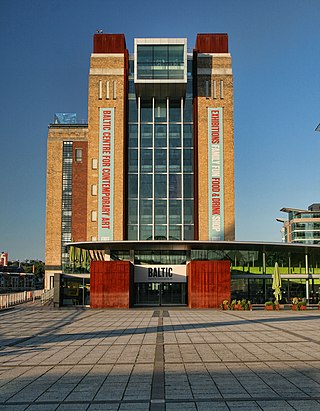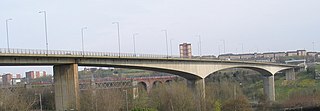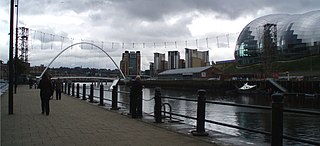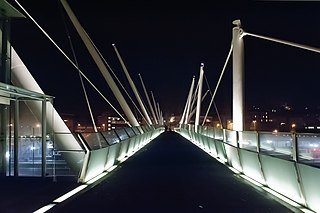
Newcastle upon Tyne, or simply Newcastle, is a city and metropolitan borough in Tyne and Wear, England. It is England's northernmost metropolitan borough, located on the River Tyne's northern bank opposite Gateshead to the south. It is the most populous settlement in the Tyneside conurbation and North East England.

Gateshead is a town in the Gateshead Metropolitan Borough of Tyne and Wear, England. It is on the River Tyne's southern bank. The town's attractions include the twenty metre tall Angel of the North sculpture on the town's southern outskirts, The Glasshouse International Centre for Music and the Baltic Centre for Contemporary Art. The town shares the Millennium Bridge, Tyne Bridge and multiple other bridges with Newcastle upon Tyne.

The Tyne Bridge is a through arch bridge over the River Tyne in North East England, linking Newcastle upon Tyne and Gateshead. The bridge was designed by the engineering firm Mott, Hay and Anderson, who later designed the Forth Road Bridge, and was built by Dorman Long and Co. of Middlesbrough. The bridge was officially opened on 10 October 1928 by King George V and has since become a defining symbol of Tyneside. It is ranked as the tenth tallest structure in Newcastle.
The year 2001 in architecture involved some significant architectural events and new buildings.

The High Level Bridge is a road and railway bridge spanning the River Tyne between Newcastle upon Tyne and Gateshead in North East England. It was built by the Hawks family from 5,050 tons of iron. George Hawks, Mayor of Gateshead, drove in the last key of the structure on 7 June 1849, and the bridge was officially opened by Queen Victoria later that year.

The Glasshouse is an international centre for musical education and concerts on the Gateshead bank of Quayside in northern England. Opened in 2004 as Sage Gateshead and occupied by North Music Trust The venue's original name honours a patron: the accountancy software company The Sage Group.

Baltic Centre for Contemporary Art is a centre for contemporary art located on the south bank of the River Tyne in Gateshead, Tyne and Wear, England. It hosts a frequently changing variety of exhibitions, events, and educational programmes with no permanent exhibition. The idea to open a centre for contemporary arts in Gateshead was developed in the 1990s, which was a time of regeneration for the local area—the Sage and Gateshead Millennium Bridge was also being conceived of in this period.

A tilt bridge is a type of moveable bridge which rotates about fixed endpoints rather than lifting or bending, as with a drawbridge. The tilting Gateshead Millennium Bridge spanning the River Tyne between Gateshead on the south bank and Newcastle upon Tyne, England, on the north is a pedestrian bridge with two large hydraulic rams at each side that tilt the structure back allowing small watercraft to pass under.

The Quayside is an area along the banks (quay) of the River Tyne in Newcastle upon Tyne and Gateshead in Tyne and Wear, North East England, United Kingdom.

The Redheugh Bridge is a road bridge spanning the River Tyne west of Newcastle upon Tyne city centre on the north bank and Gateshead town centre on the south bank, in North East England. It currently carries the A189 road.

WilkinsonEyre is an international architecture practice based in London, England. In 1983 Chris Wilkinson founded Chris Wilkinson Architects, he partnered with Jim Eyre in 1987 and the practice was renamed WilkinsonEyre in 1999. The practice has led the completion of many high-profile projects such as Gateshead Millennium Bridge, Cooled Conservatories Gardens by the Bay, Oxford's Weston Library and Guangzhou International Finance Center.

Christopher John Wilkinson was a British architect and co-founder of the architecture firm WilkinsonEyre. He was known for his techno-centric designs and execution of projects ranging from office spaces, factory floors, skyscrapers to botanical gardens. Some of his projects included the Magna Science Adventure Centre, Gateshead Millennium Bridge, Guangzhou International Finance Center, and the Gardens by the Bay in Singapore.

The Denver Millennium Bridge is the world's first cable-stayed bridge using post-tensioned structural construction. Located near LoDo, in Riverfront Park, it connects the 16th Street Mall with the Commons Park in the Central Platte Valley District of the Union Station neighborhood. The bridge is one of three pedestrian bridges between Downtown Denver and the Highland neighborhood.

The Salford Quays lift bridge, also known as the Salford Quays Millennium footbridge or the Lowry bridge, is a 91.2-metre (299 ft) long vertical lift bridge spanning the Manchester Ship Canal between Salford and Trafford in Greater Manchester, England. The pedestrian bridge, which was completed in 2000, is near the terminus of the ship canal at the old Manchester Docks. It is sited beside The Lowry theatre and gallery and links Salford Quays and MediaCityUK to Trafford Wharf and the Imperial War Museum North. It has a lift of 18 metres (59 ft), allowing large watercraft to pass beneath.

Scotswood Bridge is one of the main bridges crossing the River Tyne in North East England. It links the west end of Newcastle upon Tyne on the north bank of the river with the MetroCentre and Blaydon in Gateshead on the south bank. It is situated 5.2 km (3.2 mi) upstream of the better-known city centre bridges.

Victoria Viaduct, originally known as the Victoria Bridge, is a stone arch rail viaduct spanning the River Wear about 1 mile (1.6 km) south-east of Washington in the City of Sunderland North East England. It was built as part of the Durham Junction Railway under the supervision of Thomas Elliot Harrison.

The Bambuco Bridge was a temporary outdoor sculpture in the form of a simple suspension bridge spanning the River Tyne, England, made entirely from bamboo wood. The public art was designed and built for the SummerTyne festival, part of the NewcastleGateshead initiative.
Speirs Major Light Architecture (SMLA) is a UK lighting design practice founded by Jonathan Speirs (1958-2012) and Mark Major in 1993. The practice is noted for its illumination of many prominent buildings, including Barajas International Airport, 30 St Mary Axe, the Millennium Dome and the interior of St. Pauls Cathedral. The firm has also developed lighting master plans for several British cities, including Cambridge, Coventry, Durham, Newcastle, and for major private developments including Greenwich Peninsula and King’s Cross Central, London.

The Infinity Bridge is a public pedestrian and cycle footbridge across the River Tees in the borough of Stockton-on-Tees in northern England. The bridge is situated one kilometre downriver of Stockton town centre, between the Princess of Wales Bridge and the Tees Barrage. It connects the Teesdale Business Park and the University of Durham's Queen's Campus in Thornaby-on-Tees on the south bank of the Tees with the Tees Valley Regeneration's £320 million North Shore development on the north bank.

Forthside Bridge is a large pedestrian bridge located in the city of Stirling, in the Central Belt of Scotland. Opened on 2 May 2009, the bridge crosses Stirling railway station, a busy interchange station located on the former Caledonian Main Line and connects the city centre with the Forthside Development, a £90 million residential and leisure area on the banks of the River Forth.




























